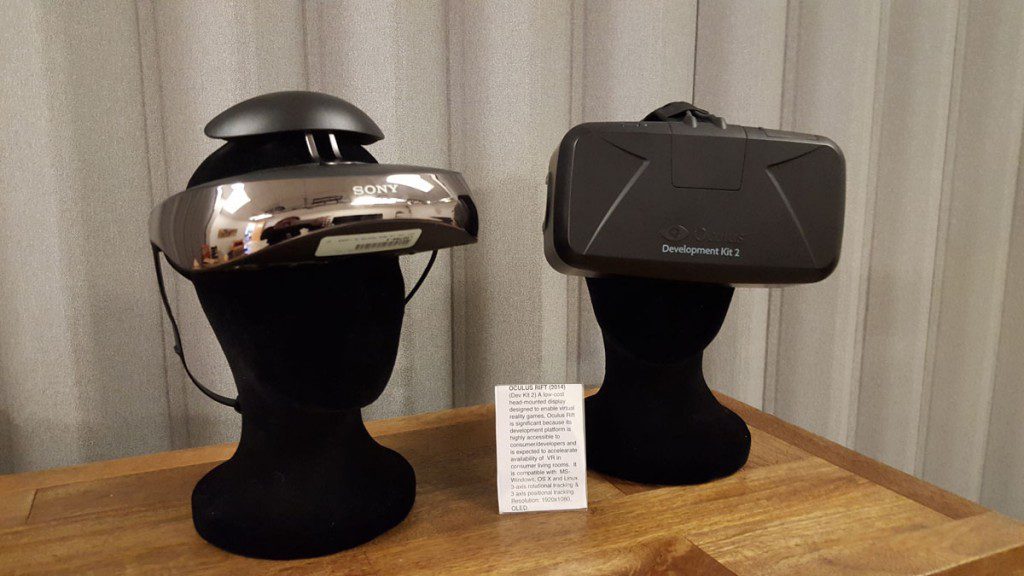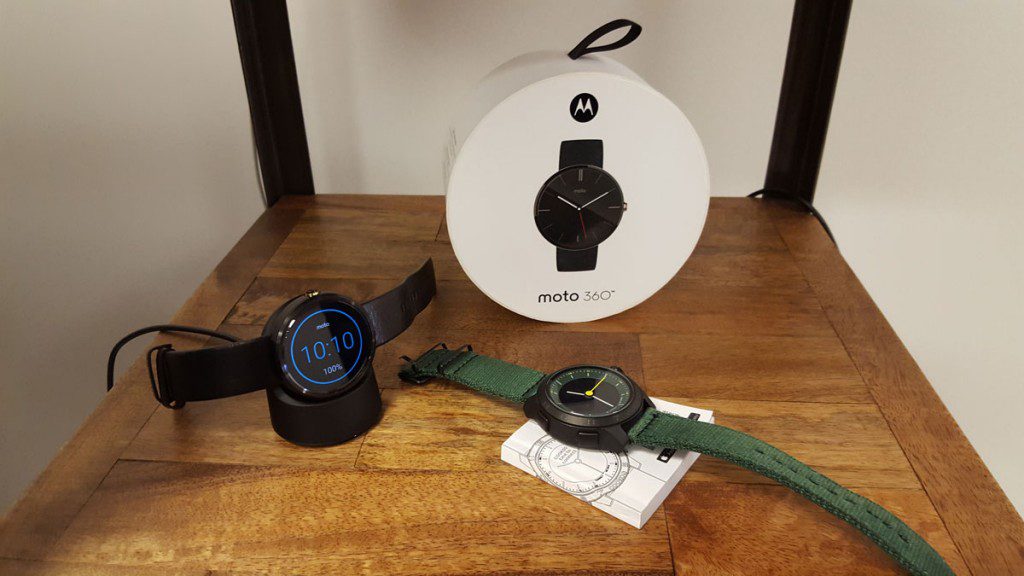Labs
Collaboration Sparks Innovation in Our Broadband Labs
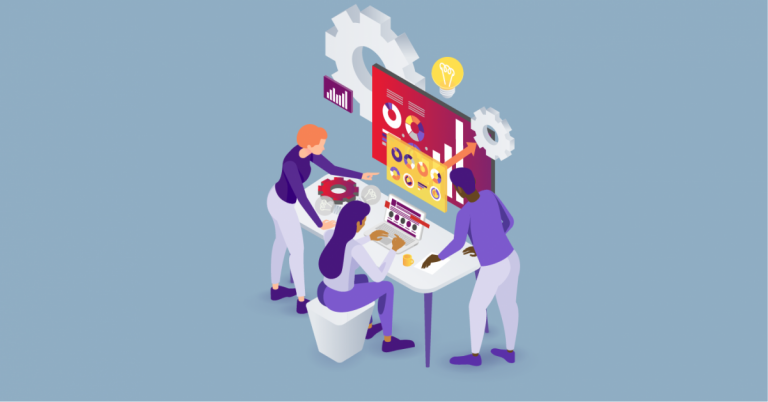
Innovation flourishes when collaboration meets experimentation and expertise. At CableLabs, this synergy is helping us blaze new trails into our digital future. Thanks to our culture of co-innovation, we’re redefining expectations and reshaping possibilities for tomorrow’s broadband technologies.
These innovations benefit not only the global industry and member companies we serve but also consumers all over the world. They move us closer to the transformative digital experiences that we anticipate in the near future.
Earlier this year, we walked you through some of our labs’ capabilities. In these purpose-built facilities, our experts breathe life into early-stage ideas, fine-tune the resulting technologies and prepare those innovations for real-world deployment.
Now, we want to give you a look inside. We invite you to watch the video below for a look at the spaces we have built to fuel imagination and ignite innovation.

Thriving on Co-Innovation
CableLabs was founded on a promise to serve as the R&D consortium for our industry and, for more than 30 years, we’ve been championing the power of co-innovation. We know that the industry is stronger when we work together. Collaboration makes us better served to transform the way people live, work, learn and play. And it all begins in our state-of-the-art labs.
Our Labs at a Glance
Research & Development Labs — In these labs, our experts hone technologies including 10G: Convergence, Mobile, Hybrid Fiber Coax and many more. The labs can be interconnected to simulate a range of scenarios.
Kyrio Test Services — Kyrio, a CableLabs subsidiary, provides testing of network equipment for operators and suppliers in the Kyrio Lab. The Kyrio Test House offers a real-world environment to test the performance of Wi-Fi devices.
System & Device Test Environments — Kyrio uses these labs to simulate a variety of scenarios when used in combination with any of our other labs. The environments include anechoic chambers and environments for research and the testing of devices for energy efficiency and radio frequency (RF) isolation capabilities.
Next-Generation Technologies Lab — In this lab, we investigate and experiment with long-term possibilities, including quantum networking mechanisms to defend against cyber-attacks and ultimately access quantum computers.
Shape the Future With Us
With top-of-the-line equipment and an eagerness for co-invention, CableLabs’ experts are available to partner with members, vendors and other collaborators. Click the button below to learn more about each of our labs and how to connect with our lab experts.
Come collaborate, and join us in building a better, brighter future.

Labs
Broadband Innovation Begins With State-of-the-Art Labs
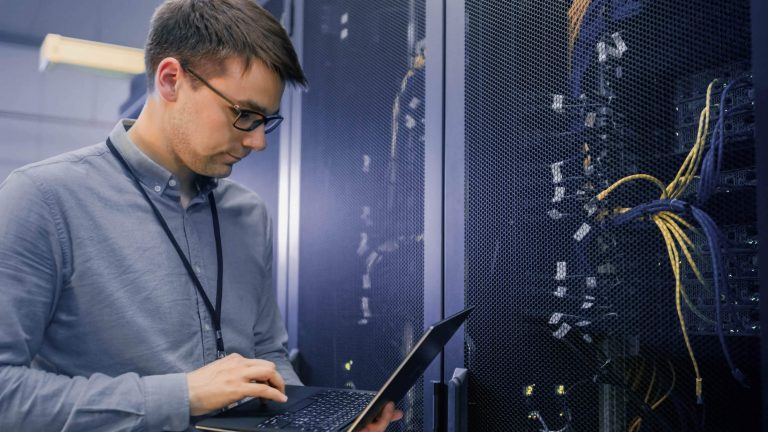
Innovation is unleashed in an environment of collaboration, experimentation and expertise. By guiding early-stage ideas from concept to real-world deployment, the industry and end users benefit. CableLabs has a range of labs designed to strengthen and support collaboration and broadband innovation. Members, vendors and other collaborators can join forces to create a multitude of network architectures and scenarios to explore and test new solutions. With this degree of interaction and cooperation, innovation is amplified.
Research & Development Labs
Our R&D Labs host advanced technologies and expertise including various unique test environments. The labs include everything from AI and machine learning to Wi-Fi, mobile and convergence. They also include hybrid fiber coax, advanced optics, fiber, cloud-native, security, PHY/RF analysis and more. These labs can be interconnected to simulate various network architectures.
Kyrio Test Services
Kyrio, a subsidiary of CableLabs, uses labs to provide testing for the unique requirements of individuals or groups of operators or vendors. These services allow devices and systems to be tested for interoperability, performance, requirements compliance, specification conformance and operator acceptance, encouraging confident new tech adoption.
System & Device Test Environments
These labs are used by Kyrio and can be configured to replicate a wide range of scenarios using large anechoic chambers, 3D printed radio frequency modeling and advanced optics benching. A specific test scenario can be simulated when combined with our other labs.
Next-Generation Technologies Lab
This lab investigates and tests technologies, such as quantum encryption, allowing experimentation with long-term possibilities. In this lab, our team works to develop new quantum networking mechanisms to defend against cyber-attacks and access quantum computers.
Moving technologies through the entire life cycle—from R&D through testing and certification and into the real world—CableLabs’ lab environments support the key phases in network technology development and deployment. As an industry, we’re stronger together. That’s why we collaborate to advance innovation for next-generation technology.
If you’re interested in collaborating to unlock the broadband of tomorrow, check out the “Lab Overview” page on our website. You’ll find a deeper dive into how these labs empower the industry to develop new service offerings, achieve enhanced levels of network efficiency and reduce the risks that come with innovation.

Labs
Successful OnGo Interoperability Test Event Held at CableLabs
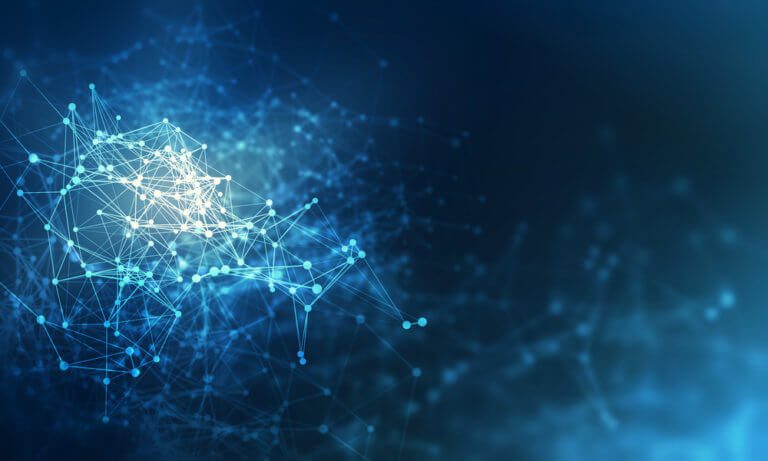
During the week of August 27th CBRS-Alliance members and government representatives gathered in Louisville Colorado at the CableLabs facility for the first CBRS OnGo™ Interoperability Test Event. The attendees consisted of a Spectrum Access System (SAS) Administrator, Citizen Band Service Device (CBSD) vendors, Domain Proxy (DP) vendors, End Unit Device (EUD) vendors and operators and representatives of various government agencies.
CBRS-Alliance is an industry organization focused on driving the development, commercialization and adoption of OnGo™ shared spectrum solutions. The CBRS Alliance enables a robust ecosystem through the management of the OnGo brand, and the OnGo Certification Program. OnGo provides an in-door and out-door LTE network that is cost-effective and can be used for either data offload or private LTE and IOT applications.
The testing covered critical functions of the CBRS ecosystem, “end-to-end” test cases, and operational flexibility. The success of the event shows the maturity of the WinnForum specification and the overall readiness of all parts of the ecosystem for Initial Commercial Deployment (ICD). This event demonstrated the ease that CBSD vendors were able to register on a SAS and become operational. One such example was a CBSD vendor and SAS administrator that had not previously interacted were able to exchange information, register the CBSD and became fully operational all in less than 30 minutes.
While certification testing focuses on protocol testing with test harnesses, this event was conducted as a real-world deployed system. With over 850 scheduled test interactions, as well as several additional unscheduled test scenarios being executed, we observed no equipment failures or unexplained results. The test cases included “end-to-end” scenarios in which EUD attached to operational CBSDs and were able to successfully access and surf the Internet.
“Last week’s Interoperability Test Event was an incredible illustration of the power of collaboration and as a result of this cooperation – across member organizations, industry liaisons and the CBRS Alliance Working Groups – we proved that the OnGo ecosystem will offer tremendous benefits to end users across market verticals,” said Alan Ewing, CBRS Alliance Executive Director. “Notably, this event provided the first ever connection attempt between certain devices and SAS'. The connections were quickly made in each case and underscored the quality of the OnGo specifications and the maturity of vendor implementations.”
In addition to hosting this event, CableLabs through Kyrio (a wholly owned subsidiary of CableLabs) supplied the PKI certificates used during the event which allowed the CBSDs and DPs to quickly switch between the SASs without having to reload new certificates. This greatly reduced the testing time and eliminated issues related to incorrect certificates being used.
As an active member of the CBRS-Alliance, CableLabs continues to contribute to the specification work that the CBRS-Alliance is developing. CableLabs also holds a position of co-lead in the Test and Certification working group which was fundamental input on this Interoperability Test Event.
For more information how to get involved in the OnGo movement please contact the CBRS-Alliance. To learn how the cable industry can benefit from OnGo please contact Luther Smith by clicking below.

Labs
3 Tips on How to Make CableLabs Certification/Qualification Testing as Painless as Possible

In the previous two blog posts in this series, we talked about what CableLabs Certification and Qualification are, as well as what they mean to both cable operators and manufacturers. In this post, we pose the question: How does a manufacturer ensure that it can get through this process successfully?
In a word: preparation.
Although a manufacturer could do that preparation itself—obtaining all the equipment, and conducting all the testing needed to prepare for a submission—the good news is that it doesn’t have to: CableLabs and Kyrio have a number of ways to help manufacturers prepare, all as a part of our mission to get properly functioning devices into the field as quickly as possible.
1. Interoperability events
The first of these are interoperability events, which are sponsored by CableLabs and jointly conducted by CableLabs and Kyrio.
After the development of a specification, and while the development of products is underway, CableLabs will hold a number of free interoperability events in the Kyrio lab facilities. These events provide an opportunity for manufacturers to test their devices while they’re still in development, using Kyrio’s state-of-the-art lab facilities. Even more important is that they provide an opportunity for multiple manufacturers to come together on neutral ground and try to get their devices working with one another—to interoperate. And when issues are found (as would be expected early in the development process), CableLabs and Kyrio engineers are available to help figure out the issues, which can even lead to a clarification of requirements in the specification, if necessary.
2. Pre-testing services
Although interoperability events can help accelerate product development and can provide some amount of pre-testing prior to a certification or qualification submission, they are not sufficient preparation in and of themselves.
For those who prefer not to purchase the equipment and dedicate the time necessary to perform that additional testing—or for those who simply prefer more privacy than an interop affords—Kyrio offers individual device manufacturers the opportunity to do flexible, customized, 1:1 testing. This is an opportunity to have the same engineers run the same tests that would be conducted as a part of certification or qualification testing—but privately, with the results going only to the manufacturer that submitted the device. The engineers can even help troubleshoot issues and validate fixes. All of this can be done before a device is ever submitted, providing an opportunity for that device to fly through testing quickly and easily.
3. A process designed to help
And what if a device does run into problems during certification or qualification testing? Even at that point, CableLabs and Kyrio have designed their process to help identify critical issues quickly and allow manufacturers the opportunity to update their devices. All of these opportunities are part of our mission to help get properly functioning devices into the field as quickly as possible.
For more information
In this blog series, we’ve looked at what CableLabs Certified and CableLabs Qualified mean, why they’re valuable for both operators and manufacturers, and how to get through the process as quickly and easily as possible. If you have any further questions, please do not hesitate to contact the following individuals:
- For questions about CableLabs Certification or Qualification programs, contact Matt Schmitt, Principal Architect at CableLabs
- For questions about how to submit a product for CableLabs Certification or Qualification programs, contact Jason Lauer, Director of Wireless and Testing Services at Kyrio
- For questions about 1:1 testing services from Kyrio, contact Ho Kim, VP of Sales and Business Development at Kyrio.
To learn more about CableLabs certification or qualification testing with Kyrio, click the button below.

Labs
Why Should I Care? The Value of CableLabs Certification/Qualification for Manufacturers
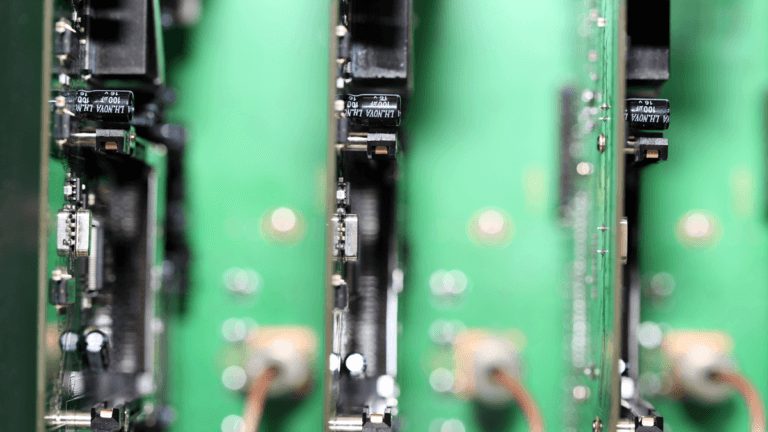
In my previous blog post in this series, we talked about the process of becoming CableLabs Certified or CableLabs Qualified, and why determining whether a device has been certified or qualified is valuable for cable operators. But what about for manufacturers?
In the previous blog post’s example—in which a cable operator was having trouble with a cable modem termination system (CMTS) in his network—imagine that the CMTS manufacturer in question had submitted its device to Kyrio for testing and that it had become CableLabs Qualified. In that case, it’s extremely likely that the problems would never have occurred. Or if a problem had occurred, it would likely be originating from a cable modem rather than the CMTS itself.
Wouldn’t that knowledge have significant value for the manufacturer, rather than simply claiming that it was DOCSIS Compliant?
Enabling Sales
Which is also why many cable operators require that their devices be CableLabs Certified or Qualified before they deploy them on their network. It’s important to note that CableLabs member companies aren’t required to purchase only certified or qualified equipment: They can purchase whatever equipment they’d like. However, in many cases, they do see the value for their operations and therefore require devices to be CableLabs Certified or Qualified as part of their purchasing process.
There are even cases in which government regulation necessitates certification. As a result, obtaining certification or qualification can—in some cases—be a requirement for selling a particular product.
A Mark of Quality
But what if you already know your device is compliant? Why do you need someone else to test it to prove that?
Over the years, we’ve had numerous cases in which a manufacturer was convinced that its product was fully compliant with one of our specifications. However, there are tests that Kyrio is simply in a better position to execute; over the course of our testing processes, we’ve often uncovered issues that could have caused major problems once a given device was deployed in the field. Not only would that cause a problem for cable operators; it would also cause major problems for the manufacturer that supplied those devices because that manufacturer will be the one on the hook to get things fixed—and to do so quickly. Therefore, it’s much more cost-effective to discover those problems early, before things are deployed, and avoid those headaches.
In fact, to the best of our knowledge, no CableLabs Certified device has ever been the subject of a hardware recall.
As a result, the CableLabs Certified and CableLabs Qualified labels have become symbols of quality, ones that have often enabled sales into new markets for manufacturers, thereby opening up new business opportunities.
Sailing through the process
All of that said, the ideal scenario would be to never find failures during certification or qualification testing so that devices sail through the process as quickly and easily as possible. In the next blog post in this series, we’ll look at some of the ways CableLabs and Kyrio help to do just that, as part of our mission of getting properly functioning devices into the field as quickly as possible.

Labs
CableLabs Introduces New Telecom Infra Project (TIP) Community Lab
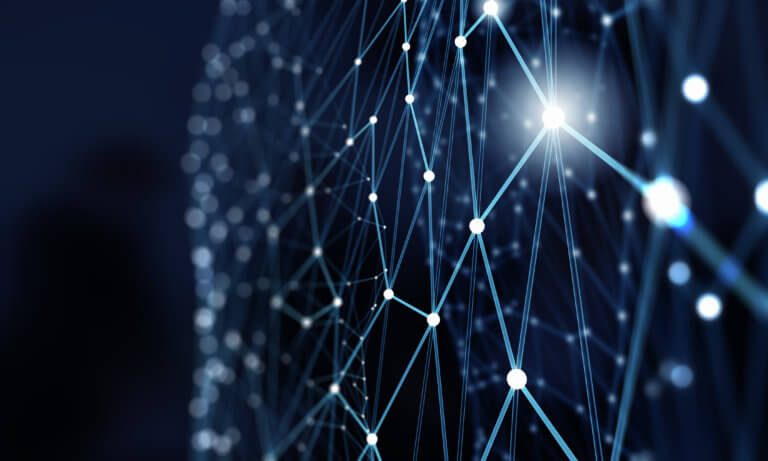
Today we are excited to announce a new venue for wireless network innovation and collaboration at CableLabs. CableLabs and the Telecom Infra Project (TIP) have opened a TIP Community Lab located at CableLabs’ headquarters in Louisville, Colorado.
What is a TIP Community Lab?
The TIP Community Lab is an integral component of community-based innovation with data-driven results. The goal of a Community Lab is to enable at-scale real-world projects that lead to adoption. These labs provide an open and collaborative working environment for members of TIP project groups to meet, test and refine the solutions they’re developing.
Currently, Community Labs are located at the offices of Facebook and SK Telecom. Today, beyond the CableLabs announcement, Deutsche Telekom announced the opening of its Community Lab in Berlin and Bharti Airtel announced that it is launching a Community Lab based in India.
What goes on at the CableLabs Community Lab?
At CableLabs, we set aside dedicated lab space for the TIP Community Lab. When at the CableLabs TIP Community Lab, engineers will have access to a bevy of state-of-the-art wired and wireless test equipment, including our:
- Channel emulators
- Traffic generators
- LTE and DOCSIS sniffers
- A host of HFC networks we use for lab work
- Various LTE UEs
- Multiple EPCs (LTE core network)
The first project to enter the CableLabs TIP Community Lab is the vRAN Fronthaul project. This project is focused on virtualization of the radio access network (RAN) for non-ideal fronthaul links (i.e. not CPRI). A key component of 5G wireless networks is going to be densification; deploying more, smaller cell sites closer to the users. Think of a small cell site inside your favorite coffee shop, or several small cells peppered throughout the hottest restaurant and bar streets in your city.
The economics of this deployment style don't support pulling fiber links to every small cell, it’s just too expensive. Therefore, a fronthaul technology capable of using “non-ideal” links to connect these small cells (i.e. DOCSIS®, G.Fast, Ethernet, Microwave), can enable new deployment economics.
The Telecom Infra Project
Founded in February 2016, TIP is an engineering-focused initiative driven by operators, suppliers, integrators and startups to disaggregate the traditional network deployment approach. The community’s collective aim is to collaborate on new technologies, examine new business approaches and spur new investments in the telecom space. TIP has more than 500 member companies, including operators, equipment vendors and system integrators. TIP currently has project groups working in the strategic areas of Access, Backhaul, and Core and Management.
CableLabs began participating in TIP a year ago and we now hold a seat on the TIP Technical Committee. We view TIP as a great opportunity for cross-pollination between the different ecosystems that influence the telecommunications networks of the future, and an excellent opportunity to leverage the diverse skills within the TIP community to create new possibilities for end users.
Everyone who has access to 4G LTE today loves how speedy their smartphone is and they want more. They want the speeds that 5G wireless networks promise. But let’s be honest, we want it for equal to or less than what we pay for our service today. TIP is focused on building networks of the future through collaboration that will give operators the flexibility to grow their networks quickly, efficiently and in a cost-effective manner while delivering the 5G speeds users will demand.
In addition, there are more than 4 billion people who are not online. Dramatic improvements in network flexibility and cost reduction would help close this digital divide. To meet these two goals, the industry should pursue new approaches to deploying wireless networks.
Interested?
CableLabs members interested in more information should check out the CableLabs Tech Brief on the topic posted in Infozone (login required). The CableLabs Community Lab is a great opportunity for telecom vendors unfamiliar with cable infrastructure to get their hands dirty with HFC and DOCSIS networks.
CableLabs is also active in other TIP project groups that may come to the Community Lab in the future. For example, we participate in the Edge Computing group. The Edge Computing group focuses on lab and field implementations for services/applications at the network edge, leveraging open architecture, libraries, software stacks and MEC. Contact CableLabs principal architect of network technologies, Don Clarke, if you want more details.
The TIP Community Lab continues the tradition of innovation at CableLabs. So stay tuned, this is just the beginning of exciting news to come from the work going on in the CableLabs TIP Community Lab.
If you got this far and you’re thinking “I want me some of that Community Lab goodness,” join TIP! You can sign up here and get involved. Project groups are open to anyone, operators and vendors, and collaboration is what it is all about and we’re excited to help facilitate.
TIP Summit 2017 - Patrick Parodi - Panel Discussion from sysadmin on Vimeo.
Labs
OPNFV’s Inaugural Plugfest Hosted by CableLabs
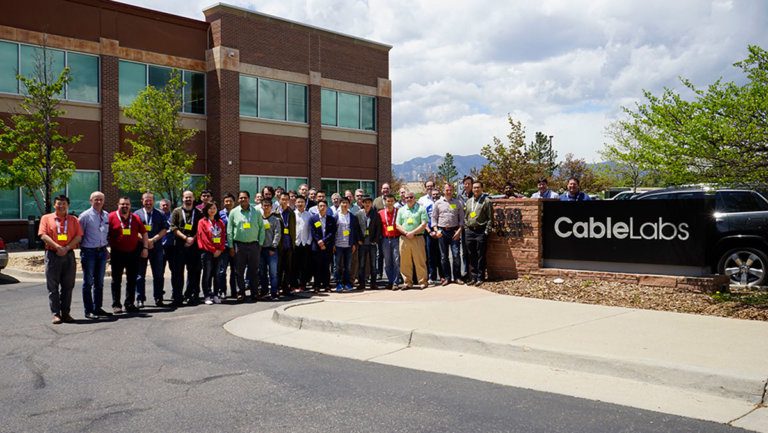
OPNFV’s first Plugfest was held at CableLabs’ facility in Louisville, CO. This event, which focused on deployment and integration of OPNFV as well as Virtual Network Function (VNF) applications, was open to both OPNFV members and non-members.
A key goal of the Plugfest was to fortify OPNFV's already unique testing projects and infrastructure (functional and performance) across new use cases from OPNFV members and other interested parties. Forty one participants from nineteen organizations--including three non-members--from around the world attended. They brought their key NFV use cases and the technologies needed to bring them to fruition. Many commented that the in-person collaboration was a major benefit.
OPNFV began eighteen months ago as an effort to ensure that open source projects such as OpenStack, OpenDaylight and others can be integrated into a carrier-grade environment that fully supports the performance and availability requirements of service provider networks.
Accordingly, OPNFV, along with CableLabs and Kyrio, hosted the plugfest to help establish testing criteria and find testing solutions to ensure NFV interoperability.
Mitchell Ashley, President and General Manager of Kyrio said, “Kyrio was founded by CableLabs to bring innovations and expertise to the market. Our experienced engineers are thought leaders in NFV. We congratulate OPNFV on its inaugural plugfest! It supports our mission to guide the community in virtualizing network services.”
The Plugfest used the test functionality first methodology and then measured results accordingly. The Functest (function testing) and Yardstick (system measurement) projects were heavily represented, along with the the Storperf (storage performance) and CPerf (controller performance) projects. In particular, the Cperf project is doing extensive SDN controller integration on various installers.
Additionally, all of the installer groups (Apex, JOID, Fuel and Compass) were represented and members extensively used these installers on different platforms (including on-site community labs that were generously provided by Huawei and Intel).
The Plugfest focused on the installation of NFVI and of VNFs (such as vIMS and vEPC) on multiple hardware platforms using multiple installers. In many instances, these combinations were attempted for the first time, and with OPNFV’s testing infrastructure in place, new VNF were benchmarked much more quickly than would otherwise be possible.
In addition to all the real-time interop testing of NFV infrastructure and applications, the Plugfest included several well-attended and valuable breakout sessions on OpenDaylight, the Functest and Yardstick testing projects, and a session on the entire OPNFV testing ecosystem. Many of the lessons from these sessions were immediately applied in the lab. All lessons from the entire Plugfest will be fed back into OPNFV Certification & Compliance Committee efforts.
As we look to the future, we hope to expand future Plugfests to multiple geographic locations. This will allow OPNFV to test our multisite applications. We will also concentrate on new use cases made possible by the Colorado release. As with this Plugfest, OPNFV will continue to reach out to other communities to get a broader spectrum of users involved in NFV application development.
Innovation
Furthering CableLabs’ Innovation Mission through University Research
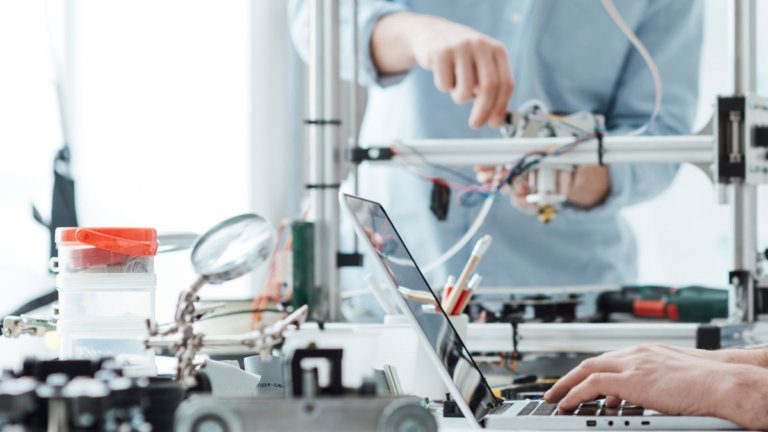

Our focus on bringing game-changing innovations to the cable industry has never been greater. But how does a relatively small organization like CableLabs create the capability to consistently bring about great innovations? The answer has to include leveraging of external relationships. Only in partnership with others will we be able to multiply our efforts and deliver on our innovation mission. The UpRamp program and our emerging co-innovation efforts (watch for our forthcoming blog post) are important vehicles to engage budding and established commercial enterprises. To complement these efforts and gain additional perspective, CableLabs is increasing its engagement with university research.
Engaging deeply with university research is relatively new for CableLabs. For the last couple of years, we have set aside a small amount of resources to contribute to research in areas of interest. We have kept the scope of our initiatives modest as we explored both new areas and new relationships. Our objective was to plug into existing research efforts, building upon established interests and resources.
The impact of these initial forays is encouraging:
- Some underpinnings of our current Full Duplex DOCSIS innovation efforts have their roots in research done at Stanford University’s ON.lab, an early participant in university research program.
- Relationships we have built at the University of Georgia and the University of North Carolina have allowed us to gain greater insights into broadband usage and how changing behaviors may impact access network evolution.
- Work with the University of Colorado has played a key role in better understanding wireless spectrum issues and helped set that stage for opening of more Wi-Fi spectrum, which was a major win for Wi-Fi users in the US. Our continued work with the university is helping us gain more insight into new spectrum opportunities.
- Work with Colorado State University has been developing new capabilities in network security. CableLabs has specifically supported development of new ways to support rapid response by service providers by monitoring network routing information in real time.
How do we build on our efforts?
As we continue to refine our approach to university engagement, we are focused on a few key characteristics that we think can increase our odds of impactful outcomes. At its core, we are seeking out researchers with interests and objectives that complement our own initiatives. Without this foundation, it’s unlikely to get either the university or CableLabs’ teams to invest the time required to build and maintain effective working level relationships.
Much more than any funding provided, we think that investment in time and interaction is critical. Only by investing our time in building relationships and trust can we have a healthy two-way exchange of ideas. Of course, Cablelabs is hoping to leverage insights from researchers, but we also want researchers to consider Cablelabs as a partner that can provide cable industry perspective, targeted interaction with cable industry players, and collaboration in the research itself. While much of our university research activities take place in the context of a specific project, we need to keep an eye on not just the project level, but in how the project contributes to building a broader and deeper relationship over time.
At CableLabs, our goal is to bring new innovation to the cable ecosystem. By growing and deepening our university relationships we can improve our own effort and help guide others. If done right, the result can pay dividends for years to come, creating a more powerful and robust innovation flow for the cable industry.
Labs
The Cost of Codecs: Royalty-Bearing Video Compression Standards and the Road that Lies Ahead

Since the dawn of digital video, royalty-bearing codecs have always been the gold standard for much of the distribution and consumption of our favorite TV shows, movies, and other personal and commercial content. Since the early 90’s, the Moving Picture Expert Group (MPEG) has defined the formats and technologies for video compression that allow all those pixels and frames to be squeezed into smaller and smaller files. For better or for worse, along with these technologies comes the intellectual property of the individuals and organizations that created them. In the United States and in many other countries, this means patents and royalties.
MPEG-LA
The MPEG Licensing Authority (MPEG-LA) was established after the development of the MPEG-2 codec to manage patents essential to the standard and to create a sensible consolidated royalty structure through which intellectual property holders could be compensated. With over 600 patents from 27 different companies considered to be essential to MPEG-2, MPEG-LA simplified the process of negotiating licensing agreements from each patent owner by anyone wishing to develop products utilizing MPEG-2. The royalty structure that MPEG-LA and the patent owners adopted for MPEG-2 was fairly simple: a one-time flat fee per codec. See table below.
The successor codec to MPEG-2, MPEG-4 Advanced Video Coding (AVC), was completed in 2003. Shortly thereafter, MPEG-LA released its licensing terms, which contained per-unit royalties and a ceiling on the amount that any one licensee must pay in a year. However, it seemed that not all parties who claimed to have essential patents for AVC were satisfied with the royalty structure established by MPEG-LA. Thus, a new AVC patent pool, managed by Via Licensing, a spin-off of Dolby Laboratories, Inc., emerged in 2004 and announced their separate licensing terms. This created a significant amount of confusion amongst those trying to license the technology. Would you end up having to license from both parties to protect yourself from future litigation? Some patent owners were in both pools; would you have to pay twice for these patents? In the end, Via Licensing signed an agreement with MPEG-LA and its licensors merged with the MPEG-LA licensors to create a single licensing authority. The royalty structure established by the MPEG-LA group for MPEG-4 added new fees to the mix. In addition to a one-time device fee (includes software and hardware applications), per-subscriber and per-title fees (e.g., VOD, digital media) were added. These additional fees have deterred many cable operators and other MVPDs from adopting MPEG-4. Royalties were also established for over-the-air broadcast services, while free Internet broadcast video (e.g YouTube, Facebook) remained exempt. See table below.
The latest MPEG video codec is called High Efficiency Video Coding (HEVC), and with it comes the latest licensing terms from MPEG-LA. A flat royalty per device is incurred for those shipping over 100,000 devices to end-users. Companies with device volumes under 100,000 will pay no royalties. In addition, the royalty cap for organizations was raised substantially. Most companies distributing HEVC encoders/decoders will not be charged royalties because they will easily fall under the 100,000-unit limit. Larger companies that sell mobile devices (Samsung, LG, etc.), OS vendors (Microsoft), and large media software vendors (Adobe, Google) will likely be the ones paying HEVC royalties. Learning from the lackluster adoption rate of MPEG-4 by content distributors, there are no royalties on content distribution. This seems like a step in the right direction.
The following table details the royalty structures established from the days of MPEG-2 up to the proposed terms for HEVC.
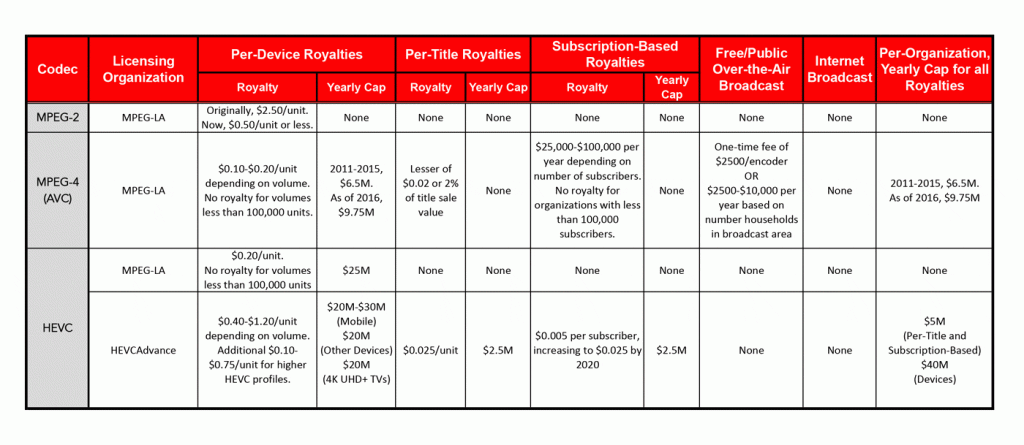
Download PDF version
Trouble on the Horizon
As one might expect, many companies who hold patents that they claim are essential to HEVC were not happy with the MPEG-LA terms and have instead joined a new licensing organization, HEVCAdvance. In early 2015, when HEVCAdvance first announced their licensing terms, it caused quite a stir in the industry. Not only did they have much higher per-device rates, but there was also a very vague “attributable revenue” royalty for content distributors and any other organization that utilizes HEVC to facilitate revenue generation. On top of all that, there were no royalty caps.
In December, 2015, due in no small part to the media and industry backlash that followed the release of the original license terms, HEVCAdvance released a modified terms and royalties summary. Royalties for devices were lowered slightly, but still significantly higher than what MPEG-LA has established – and with no yearly cap. Additionally, there are slightly different royalty rates depending on the type of device (e.g., mobile phone, set-top-box, 4K UHD+ TV). No royalties are assessed for free, over-the-air and Internet broadcast video. However, per-title and per-subscriber royalties remain. See table above. The HEVCAdvance terms also assess royalties with no caps for past sales of per-title and subscription-based units. Finally, there is an incentive program in which early adopters of the HEVCAdvance license can receive limited discounts on royalties for past and future sales.
It is important to note that the companies that participate in each patent pool (HEVCAdvance, MPEG-LA) are not the same. If the two patent pools are not reconciled or merged, licensees may have to sign agreements with both organizations to better protect themselves against infringement. This will result in a substantial financial impact to the device vendors (TVs, Browsers, Operating Systems, Media Players, Blu-Ray Players, Set-Top Boxes, GameConsoles, etc). Of course, content distributors are also unhappy with the HEVCAdvance terms that revert back to the content-based royalties of MPEG-4, and a higher cap of $5M per year. As a result, you may expect the content distributors to pass a portion of their subscription- and title-based royalties on to their customers which results in increased prices for consumers like you and me.
Update (2/3/16): Technicolor announced that they will withdraw from HEVCAdvance and license its patents directly to device manufacturers. While this is an encouraging sign (and good for content distributors), I'm curious as to why they did not just join MPEG-LA. If more and more companies take the route of individual licensing, it may make the process of acquiring licenses for HEVC more complex.
The Royalty-Free Codec Revolution
In response to the growing concerns regarding the costs of using and deploying MPEG-based codecs, numerous companies and organizations have developed, or are planning to develop, alternatives that are starting to show some promise.
Google VPx
Google, through its acquisition of On2 Technologies, has developed the VP8 and VP9 codecs to compete with AVC and HEVC, respectively. Google has released the VP8 codec, and all IP contained therein, under a cross-license agreement that provides users royalty-free rights to use the technology. In 2013, Google signed an agreement with MPEG-LA and 11 MPEG-LA AVC licensors to acquire a license to VP8 essential patents from this group. This makes VP8 a relatively safe choice, legally speaking, for use as an alternative to AVC. The agreement between Google and MPEG-LA also covers one “next-generation” codec. According to my discussions with Google, this is meant to be the VP9 codec. The VP8 cross-license FAQ indicates that a VP9 cross-license is in progress, but nothing official exists to-date.
Most of the content served by Google’s YouTube is compressed with VP8/VP9 technology. Additionally, numerous software and hardware vendors have added native support for VPx codecs. Chrome, Firefox, and Opera browsers all have software-based VP8 and VP9 decoders. Recently, Microsoft announced that they would be adding VP9 decode support to their Edge browser in an upcoming release. On the hardware side, Google has signed agreements with almost every major chipset vendor to add VP8/VP9 functionality to their designs.
From a performance standpoint, we feel that VP8/AVC and VP9/HEVC are very similar. Numerous experiments have been run to try to assess the relative performance of the codecs and, while it is difficult to do an apples-to-apples comparison, they seem very close. If you’d like to look for yourself, here is a sampling the many tests we found:
- https://www.ietf.org/mail-archive/web/rtcweb/current/msg09064.html
- Mukherjee, et al., Proceedings of the International Picture Coding Symposium, pp. 390-393, Dec. 2013, San Jose, CA, USA.
- Grois, et al., Proceedings of the International Picture Coding Symposium, pp. 394-397, Dec. 2013, San Jose, CA, USA.
- Bankoski, et al., Proceedings of IEEE International Conference on Multimedia and Expo, pp. 1-6, July 2011, Barcelona, ES.
- Rerabek, et al., Proceedings of the SPIE Applications of Digital Image Processing, XXXVII, vol. 9217, August 2014, San Diego, CA, USA
- Feller, et al., Proceedings of the IEEE International Conference on Consumer Electronics, pp. 57-61, Sept. 2011, Berlin, DE.
- Kufa, et al., Proceedings of the 25th International Radioelektronika Conference, pp.168-171, April 2015, Pardubice, CZ
- Uhrina, et al., 22nd Telecommunications Forum (TELFOR), pp. 905-908, Nov. 2014, Belgrade, RS
An Alliance of Titans
At least in part in reaction to the HEVCAdvance license announcement in 2015, a collection of the largest media and Internet companies in the world announced that they were forming a group with the sole goal of helping develop a royalty-free video codec for use on the web. The Alliance for Open Media (AOM), founded by Google, Cisco, Amazon, Netflix, Intel, Microsoft, and Mozilla, aims to combine their technological and legal strength to ensure the development of a next-generation compression technology that will be both superior in performance over HEVC and free of charge.
Several of the companies in AOM have already started work on a successor codec. Google has been steadily progressing on VP10. While Cisco has introduced a new codec called Thor. Finally, Mozilla has long been working on a codec named Daala, which takes a drastically different approach to the standard Discrete Cosine Transform (DCT) algorithm used in most compression systems. Cisco, Google, and Mozilla have all stated that they would like to combine the best of their separate technologies into the next generation codec envisioned by AOM. It is likely that this work would be done in the IETF NetVC working group, but not much has been decided as of yet.
The Future is Free?
Not sure we can say this statement with utmost confidence; but it seems clear that the confusing landscape of IP-encumbered video codecs is driving industry towards a future where digital video--the predominant leader in video traffic on the internet--may truly be free from patent royalties.
Greg Rutz is a Lead Architect in the Advanced Technology Group at CableLabs.
Special thanks to Dr. Arianne Hinds, Principal Architect at CableLabs, and Jud Cary, Deputy General Counsel at CableLabs for their contributions to this article.
Consumer
Gadgets Galore in our Comfortable Living Room Lab
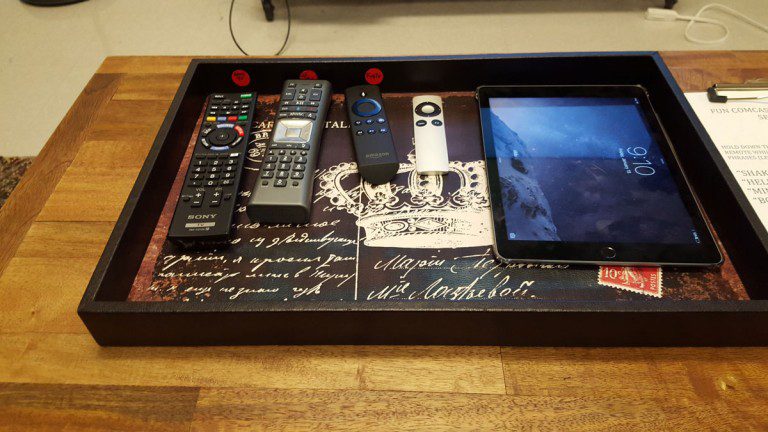
Someone once said, “Seeing is Believing.” At CableLabs, we believe that “Doing is Knowing.” With this in mind, we crafted a space in our Sunnyvale, CA facility that we call the Moveable Experience Lab (aka “MEL”).
The MEL simulates a consumer living room. The space has been intentionally designed as a “safe place” to frame your own ideas and opinions about experiences influencing consumers habits today.
Everything in the lab is meant to be touched, used and experimented with – similar to a Discovery Museum for adults. Haven’t tried Oculus Rift, VR or 360 Content? We’ve got it. How about the Amazon Echo? We’ve got it. HBO GO, Xfinity1, Google Glass and smart watches and UHD TV’s…check, check, check and check. The good news? Unlike crowded conference floors or company demos, visitors are not rushed to take their turn or see a limited aspect of the experience. Visitors are encouraged to take as much time with any technology they are interested in so that they can get a full sense of what might be the big “wow” associated with any one of these consumer tech experiences. Further, CableLabs personnel are frequently on hand to offer their own insights – or just to converse about the technology – without the pressure of press or others waiting for you to form an “official” opinion. Sometimes, just talking about what you’ve observed helps to ensure that the learning sticks or could inspire you to have new ideas about new possibilities.
Right now, MEL contains several experience exhibits:
Battle for the Living Room
Experiences for the Sony 65” UHD Display
- Comcast: Xfinity 1 with Voice Remote - demonstrating personalization (guide preference), recommendations, and voice navigation via Comcast Voice Remote.
- AppleTV: Demonstrating uber aggregation and an ultra simplified remote.
- Amazon KindleFire TV: Features an elegant voice remote and categorized discovery guide (with recommendations based on viewing habits).
- Playstation 4 (with 2 gaming controls) featuring Playstation Now: An ecosystem for games, movies, music, etc.
The Evolution of 3D Experiences in Head Mounted Displays/Mobile Devices
This exhibit shows the progression of virtual reality in the head mounted display form factor. This is probably one of the fastest growing areas of technology and, by all counts, is staged to become a significant consumer trend.
- Google Cardboard (used with any smartphone): Google Cardboard was handed out free last year at Google I/O as an example of a low-cost system to encourage interest and development in VR and VR applications.
- Google Glass: 2nd Generation: The last beta generation of Google Glass. Google Glass was a large-scale experiment meant to “free people from looking down at their cell phones — and look up.”
- Oculus Rift (version 2) (non functional): Representation of the state of development in 2012.
- Samsung Gear VR Headset Low Cost Headset (run on Android Phone): Demonstrates growing number of 3D-interactive titles and games as well as 360 Degree content. As a $99 accessory to a smartphone, this product is expected to cause the tipping point that will be instrumental in bringing Virtual Reality experiences to the masses.
Evolution of the Smart Watch
Like the mobile OS battles, Apple and Google are set to compete for the wrists of consumers — and life-style brand status. Visitors to the MEL lab can gain a sense of how quickly the wearable market has been populated and is evolving.
- 2012 - MetaWatch: First smartwatch of the latest wave of Smartwatches
- 2013-14 – AndroidWear Watches (built from same SDK, different Brand UX): Requires android phone to work. Smart watches with apps, tracking, and mobile notifications and a market place of 4K+ apps.
- Motorola 360 – Round Watch: First round interface (note the UX)
- Samsung Gear: Samsung’s interpretation of the Android Smartwatch SDK
- 2015 - AppleWatch (requires iPhone to work): A watch experience aimed at the luxury experience featuring a high-end display, materials, ApplePay and a 8.5K+ apps.
Tablet Experiences (Apps)
- Watchable: Comcast’s new, cross-platform video service that curates a selection of the best content from popular online video networks and shows in an easy-to-use experience — no need for a cable subscription. Specifically curating content from digital content that will appeal to younger generations than standard cable.
- HBONow : OTT viewing experience – available to anyone who wants to run HBO on a mobile device.
- HBOGo: OTT Viewing experience – available to HBO’s premium cable subscribers.
- Xfinity TV Remote: If you don’t want to use the remote control and your tablet is more handy — there’s an app for that!
- Unstaged: American Express – 360 experiences
We believe that having access to a space like MEL helps CableLabs employees establish opinions on consumer technology that are based on facts as well as experience with the real products. These insights enable us to ground our insights and set the stage for innovation beyond what already is on market.
The next time you are in Sunnyvale, make some time to stop by and experience MEL. No appointment is necessary, but be forewarned…sudden attacks of binge-watching have been known to afflict visitors and you might just be inspired to create a product on your own!
Mickie Calkins is the Director of Co-Innovation & Prototyping in the Strategy & Innovation Group at CableLabs.



